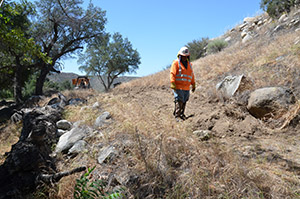

The Soboba Cultural Resource Department was established in 2004 for the preservation of Tribal Cultural Resources and Historic Properties located within the Luiseño and Cahuilla traditional use areas. Department staff are well versed in applicable laws and methods of cultural resource preservation including but not limited to, National Historic Preservation Act and National Environmental Policy Act compliance, professional archaeological standards, California Assembly Bill 52 and Senate Bill 18 compliance, applicable state laws and public resource codes, as well as being knowledgeable in traditional tribal customs and protocols.
These specialties provide the support that is essential during consultation with local, state and federal agencies who’s permits may have an impact on tribal cultural resources, cultural sites, or traditional cultural landscapes and places. Mitigation created during these consultations are implemented when projects are proposed in areas where cultural resources are likely to be affected. Often these mitigation efforts may consist of full avoidance of a specific location, culturally sensitive methods for treatment and disposition of inadvertently discovered cultural resources, controlled grading and tribal monitoring.
The Tribal Historic Preservation Officer (THPO) is responsible for the administration of any or all functions of a State Historic Preservation Officer (SHPO) within tribal lands. These duties include but are not limited to the adherence of 36 CFR Part 800 Protection of Historic Properties and Section 106 of the National Historic Preservation Act, through advising and assisting Federal and state agencies, as well as local governments in carrying out their historic preservation responsibilities. These duties are carried out through consultation with Federal agencies on Federal undertakings that may affect tribal historic properties, and on any plans to protect, manage, reduce, or mitigate harm to such properties. The THPO is also responsible for cooperating with the Secretary of the Interior, the Advisory Council on Historic Preservation, and other Federal and state agencies, local governments, organizations, and individuals to ensure that tribal historic properties are taken into consideration at all levels of planning and development, as well as identifying and nominating properties to the National Register of historic Places, administering applications for listing in the National Register of Historic Places.
